RTX 3050 vs Arc A750 GPU faceoff — Intel Alchemist goes head to head with Nvidia's budget Ampere
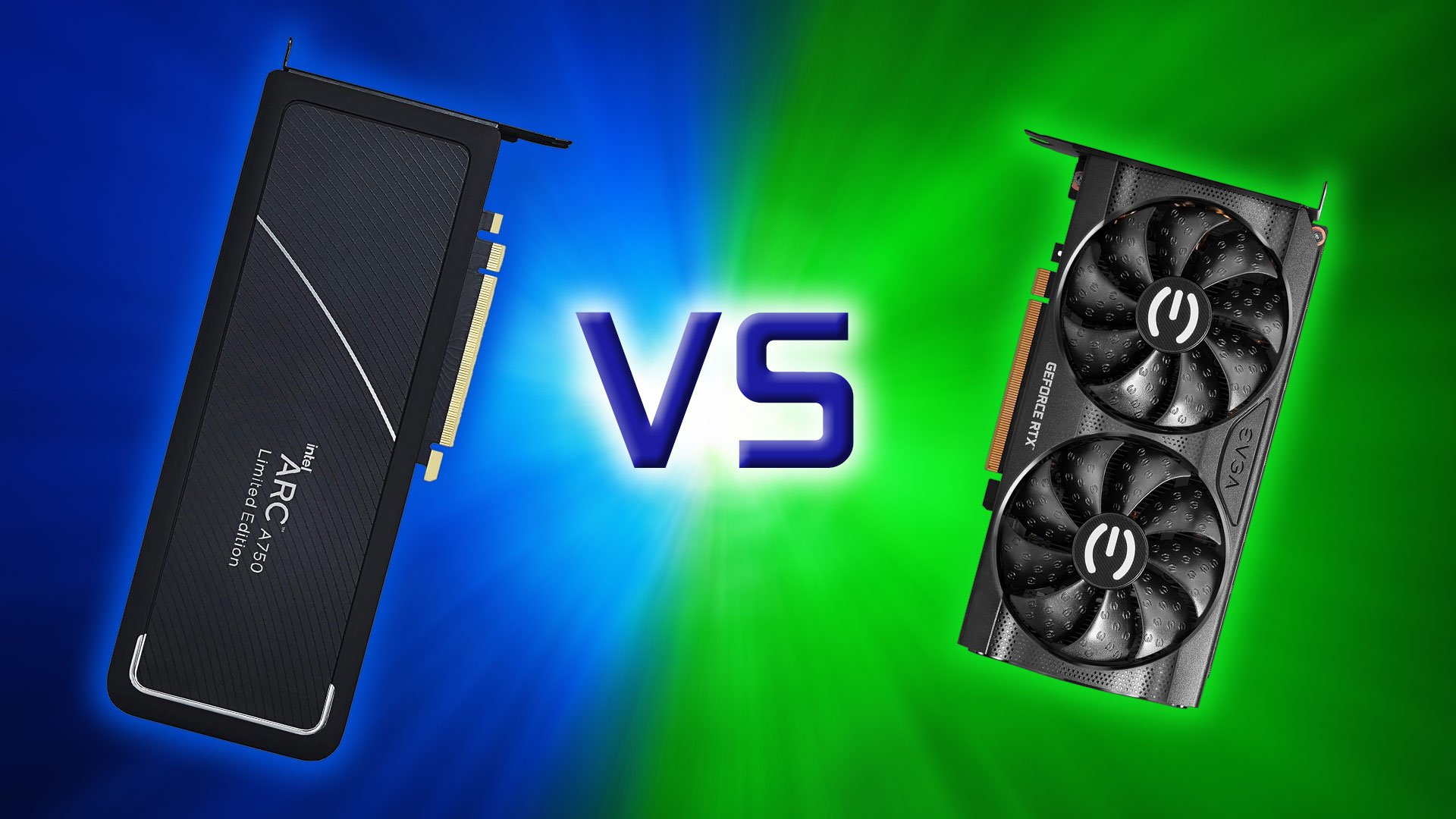
Comparing the RTX 3050 and Arc A750 continues from our previous look at the RTX 3050 vs RX 6600, this time swapping out AMD for Nvidia in the popular $200 price bracket. Nvidia failed to take down AMD, but does it fare any better against Intel? These are slightly older GPUs, as no company has seen fit to offer anything more recent in the budget sector, so let's find out who wins this matchup.
The RTX 3050 debuted at the start of 2022 and represents Nvidia's latest xx50-class desktop graphics card, with no successor in the pipeline for the RTX 40-series (at least that we know of). The card nominally launched at $249, though we were still living in an Ethereum crypto mining world so most cards ended up selling well above that mark. Two and a half years later, it's one of the few RTX 30-series Ampere GPUs that remains relatively available, and it's now going for around $199, the rest having been supplanted by the newer Ada Lovelace GPUs.
The Arc A750 is Intel's mainstream / budget offering based on the Arc Alchemist GPU architecture. It debuted two years ago and has been one of the most promising offerings for Intel's first lineup of discrete graphics cards in over 20 years. Driver support was a big concerns at launch, but Intel has made excellent progress on that front, which could sway things in favor of the Intel GPU in this face-off. Maybe. Similar to the RTX 3050, the A750 started out as a $289 graphics card, then saw an official price cut to $249, and now it's often selling at or below $199 in the wake of new graphics card releases from Nvidia and AMD.
While we're now a couple of years past the 3050 and A750 launch dates, they remain relevant due to the lack of new sub-$200 options. So, let's take an updated look at these budget-friendly GPUs in light of today's market and see how they stack up. We'll discuss performance, value, features, technology, software, and power efficiency — and as usual, those are listed in order of generally decreasing importance.
RTX 3050 vs Arc A750: Performance
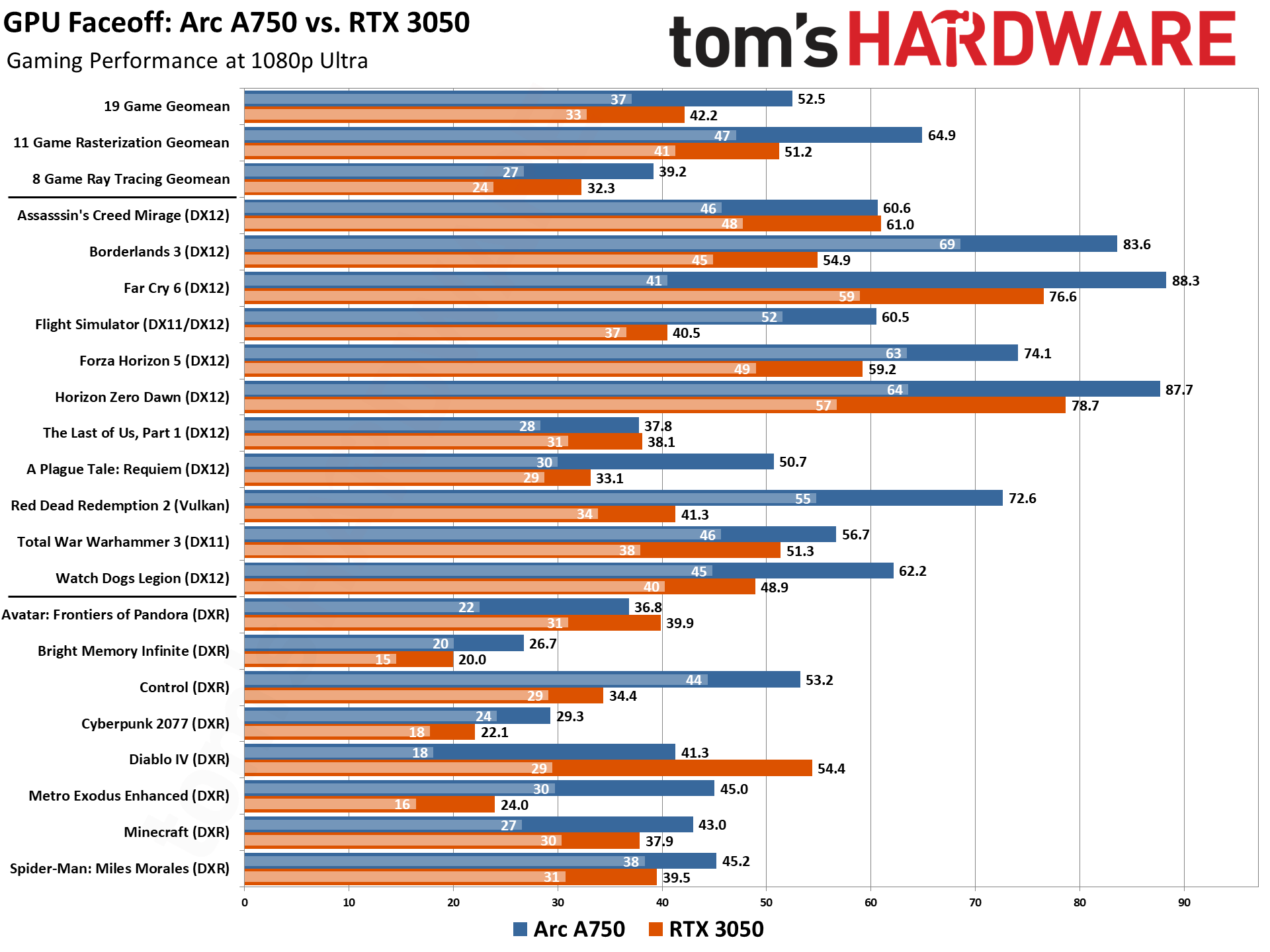
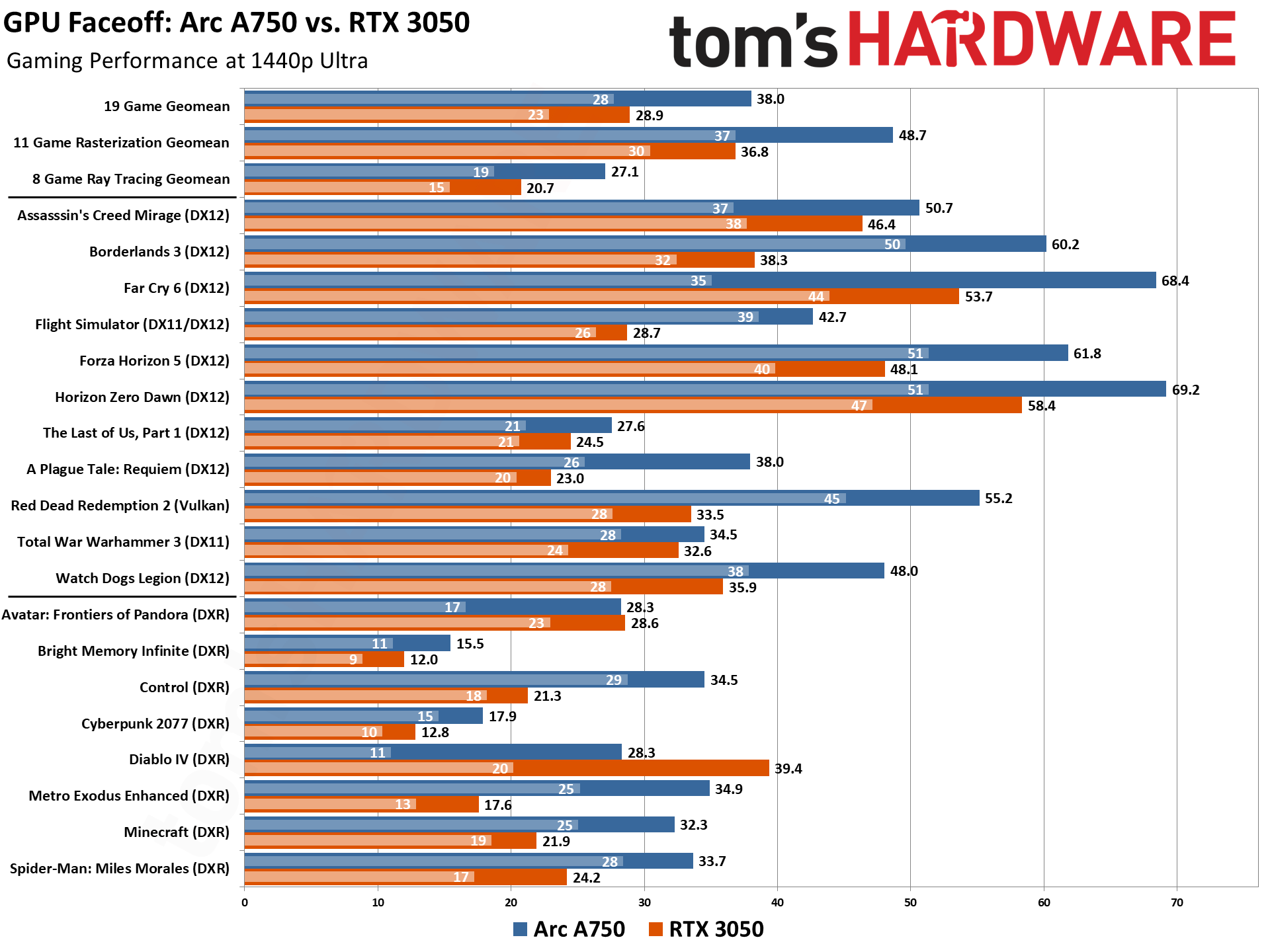


Intel made a big deal about the Arc A750 targeting the RTX 3060 when it launched, so dropping down to the RTX 3050 should give the A750 an easy victory... and it does. The A750 shows impressive performance compared to the 3050, with both rasterization and ray tracing performance generally favoring the Intel GPU by a significant margin.
At 1080p ultra the Arc card boasts an impressive 25% performance lead over the RTX 3050 in our 19 game geomean. That grows to 27% when looking just at rasterization performance, and conversely shrinks to 21% in the ray tracing metric. Regardless, it's an easy win for Intel. The RTX 3050 does a bit better at 1080p medium, but the Arc A750 still wins by a considerable 18% across our test suite.
That's not to say that Intel wins in every single game of our test suite, however, and that's likely the same old issue of drivers popping up in the exceptions. Diablo IV (with ray tracing — it runs much better in rasterization mode) is clearly not doing well on Arc. Avatar, another more recent release, also performs somewhat worse. The Last of Us and Assassin's Creed Mirage, the other two newer releases, are at best tied (ultra settings) and at worse slightly slower on the A750. You might be noticing a pattern here. So while Intel drivers have gotten better, they're still not at the same level as Nvidia. Most of the other games favor the A750 by a very wide margin of roughly 25–55 percent.
The lead gets more favorable for the Arc A750 as we increase resolution. At 1440p, the Intel GPU is roughly 32% ahead of the RTX 3050, in all three of our geomeans. The only game where the RTX 3050 still leads is Diablo IV, again likely a driver issue with the ray tracing update that came out earlier this year. (Our advice would be to turn off RT as it doesn't add much in the game, but we do like to use it as a GPU stress test.)
Things get a little bumpy for the A750 at 4K ultra, with good rasterization performance — even better compared to the 1440p results with a whopping 43.6% lead — but several issues in ray tracing games. The Arc card looses a decent chunk of its lead in RT, sliding down to 17% overall, but with three games (Diablo IV again, Cyberpunk 2077, and Bright Memory Infinite) all performing better on the 3050. Diablo IV routinely dips into the single digits for FPS, and it generally needs more than 8GB of VRAM to run properly at 4K with all the RT effects enabled.
Performance Winner: Intel
It's a slam dunk for the Arc A750 in this round. The Intel GPU dominates the RTX 3050 even in ray tracing games, an area where Nvidia often holds a strong lead over rival AMD's competing GPUs. Intel may still have driver issues to work out, but the underlying architecture delivers good performance when properly utilized, at least relative to Nvidia's previous generation budget / mainstream GPUs.
RTX 3050 vs Arc A750: Price
Pricing has fluctuated quite a bit in recent days, what with Prime Day sales. We saw the Arc A750 drop as low as $170 at one point, but over a longer period it's been hanging out at the $200 mark. RTX 3050 8GB cards also cost around $200 — and again, note that there are 3050 6GB cards that cut performance quite a bit while dropping the price $20–$30; we're not looking at those cards.
If you want to be fully precise, the RTX 3050 often ends up being the higher-priced card. The cheapest variant, an MSI Aero with a single fan, costs $189 right now. $5 more gets you a dual-fan MSI Ventus 2X. Arc A750 meanwhile has sales going right now that drop the least expensive model to $174 for an ASRock card, or $179 for a Sparkle card. Both are "normally" priced at $199, however, and we expect them to return to that price shortly.
But RTX 3050 inventory isn't that great, and before you know it, you start seeing 3050 listings for $250, $300, or more. That's way more than you should pay for Nvidia's entry-level GPU. Arc A750 listings are far more consistent at hitting the $200 price point, with most models hitting the $199.99 price point exactly. There may be fewer A750 models overall (only seven exist that we know of), but most are priced to move.
Pricing: Tie
While we could say the Arc A750 the winner, based on current sales, in general we've seen the two GPUs separated by just $5–$10. Prices will continue to fluctuate, and inventory of the RTX 3050 could also disappear. But for the here and now, we're declaring the price a tie because there's usually at least one inexpensive card for either GPU priced around $190–$200. If there's not, wait around for the next sale.
RTX 3050 vs RX 6600: Features, Technology, and Software
| Graphics Card | RTX 3050 | Arc A750 |
|---|---|---|
| Architecture | GA106 | ACM-G10 |
| Process Technology | Samsung 8N | TSMC N6 |
| Transistors (Billion) | 12 | 21.7 |
| Die size (mm^2) | 276 | 406 |
| SMs / Xe-Cores | 20 | 28 |
| GPU Cores (Shaders) | 2560 | 3584 |
| Tensor / XMX Cores | 80 | 448 |
| RT Cores/Ray Accelerators | 20 | 28 |
| Boost Clock (MHz) | 1777 | 2400 |
| VRAM Speed (Gbps) | 14 | 16 |
| VRAM (GB) | 8 | 8 |
| VRAM Bus Width | 128 | 256 |
| L2 / Infinity Cache | 2 | 16 |
| Render Output Units | 48 | 128 |
| Texture Mapping Units | 80 | 224 |
| TFLOPS FP32 (Boost) | 9.1 | 17.2 |
| TFLOPS FP16 (AI) | 73 | 138 |
| Bandwidth (GBps) | 224 | 512 |
| TDP (watts) | 130 | 225 |
| Launch Date | Jan 2022 | Oct 2022 |
| MSRP | $249 | $249 |
| Online Price | $200 | $200 |
Unlike our recent RX 6600 vs. Arc A750 comparison, Intel's Arc A750 and Alchemist architecture look a lot more like Nvidia's RTX 3050 and its Ampere architecture. Both the Arc A750 and RTX 3050 sport hardware-based acceleration for AI tasks. The RTX 3050 boasts third generation tensor cores, each of which is capable of up to 512 FP16 operations per cycle. The Arc A750 has Xe Matrix eXtensions (XMX), with each XMX core able to do 128 operations per cycle. That ends up giving the A750 a relatively large theoretical advantage. Both GPUs also come with good ray tracing hardware.
But let's start with the memory configurations. The RTX 3050 uses a mainstream 128-bit wide interface accompanied by 8GB of GDDR6 operating at 14 Gbps. The Arc A750 has 256-bit interface, still with only 8GB of capacity, but the memory runs at 16 Gbps. The bus width and memory speed advantage on the A750 gives the Intel GPU a massive advantage in memory bandwidth, with roughly 1.3X as much bandwidth as the RTX 3050 — 512GB/s vs 224 GB/s. And there's no large L2/L3 cache in either of these architectures to further boost the effective bandwidth.
It's worth mentioning that Nvidia GPUs generally have less memory physical memory bandwidth than their similarly priced competition. Nvidia compensates for this fact with its really good memory compression, which reduces the memory load. We aren't sure if Intel is using memory compression or how good it might be, but regardless, it's obvious from the performance results that the A750's robust memory subsystem has more than enough bandwidth to defeat the RTX 3050.
The physical dimensions of the GPUs are also quite different. The Arc A750's ACM-G10 uses a colossal 406 mm^2 die, while the RTX 3050 uses a significantly smaller die that's only 276 mm^2. Of course, Ampere GPUs are made on Samsung's 8N node while Intel uses TSMC's newer and more advanced N6 node. Transistor count scales with size and process technology, with the A750 packing 21.7 billion transistors compared to the RTX 3050's comparatively tiny 12 billion.
These differences can be seen as both a pro and con for the Arc A750. Its bigger GPU with more transistors obviously helps performance compared to the RTX 3050. However, this also represents a weakness of Intel architecture. The fact that Intel has 80 more transistors and a chip that's nearly 50% larger, on a more advanced node, means that the ACM-G10 has to cost quite a bit more to manufacture. It also shows Intel's relative inexperience in building discrete gaming GPUs, and we'd expect to see some noteworthy improvements with the upcoming Battlemage architecture.
Put another way, if we use transistor count as a measuring stick, the Arc A750 on paper should be performing more on par with the RTX 3070 Ti. That's assuming similarly capable underlying architectures, meaning Intel's design uses a lot more transistors to ultimately deliver less performance. Yes, the A750 beats up on the 3050 quite handily, but the RTX 3070 wipes the floor with roughly 60% higher performance overall — and still with fewer transistors and a smaller chip on an older process node.
We can make similar point when it comes to raw compute performance. On paper, the A750 delivers 17.2 teraflops of FP32 compute for graphics, and 138 teraflops of FP16 for AI work. That's 89% more than the RTX 3050, so when combined with the bandwidth advantage, you'd expect the A750 to demolish Nvidia's GPU. It wins in performance, but even a 25% advantage is a far cry from the theoretical performance.
It's a bit more difficult to make comparisons on the RT hardware side of things. Nvidia tends to be cagey about exactly how it's RT cores work, often reporting things like "RT TFLOPS" — using a formula or benchmark that it doesn't share. What we can say is that, based on the gaming performance results, when Arc drivers are properly optimized, the RT throughput looks good. We see this in Minecraft, a demanding "full path tracing" game that can seriously punish weaker RT implementations. Pitting the A750's 28 ray tracing cores against the 3050's 20 cores, Intel comes out roughly 40% faster at 1080p medium as an example. So, 40% more cores, 40% more performance.
While Intel might have the hardware grunt, however, software and drivers heavily favor Nvidia. Nvidia has been doing discrete gaming GPU software/driver development much longer than Intel, and Intel has previously admitted that all of its prior work on integrated graphics drivers didn't translate over to Arc very well. Nvidia's drivers are the gold standard other competitors need to strive to match, and while AMD tends to be relatively close these days, Intel still has some clear lapses in optimizations. As shown earlier, check out some of the newer games (Diablo IV, Avatar, The Last of Us, and Assassin's Creed Mirage) and it's obvious those aren't running as well on the A750 as some of the older games in our test suite.
Intel has come a long way since the initial Arc launch, especially with older DX11 games, but its drivers still can't match AMD or Nvidia. Intel has a good cadence going with driver updates, often releasing one or more new drivers each month, but it still feels like a work in progress at times. Arc generally doesn't play as well as its competitors in day one releases, and we've seen quite a few bugs over the past year where you'll need to wait a week or two before Intel gets a working driver out for a new game.
Features are good for Intel, but again nowhere near as complete as what Nvidia offers. Nvidia has DLSS, Intel has XeSS (and can also run AMD FSR 2/3 when XeSS isn't directly supported). As far as upscaling image quality goes, DLSS still holds the crown, but XeSS 1.3 in particular looks better in almost all cases that we've seen than FSR 2. Frame generation isn't something we're particularly worried about, but Nvidia has a bunch of other AI tools like Broadcast, VSR, Chat RTX. It also has Reflex and DLSS support is in far more games and applications than XeSS.
The driver interface also feels somewhat lacking on Intel. There's no way to force V-sync off as an example, which can sometimes impact performance. (You have to manually edit a configuration file to remove vsync from Minecraft, for example — if you don't, performance suffers quite badly.) Maybe for the uninitiated the lack of a ton of options to play with in the drivers could feel like a good thing, but overall it's clearly a more basic interface than what Nvidia offers.
Features, Technology, and Software Winner: Nvidia
This one isn't even close, at all. The Intel Arc experience has improved tremendously since 2022, but it still lags behind. Intel isn't throwing in the towel, and we're hoping that Battlemage addresses most of the fundamental issues in both the architecture as well as software and drivers. But right now, running an Arc GPU can still feel like you're beta testing at times. It's fine for playing popular, older games, but newer releases tend to be much more problematic on the whole.
RTX 3050 vs Arc A750: Power Efficiency
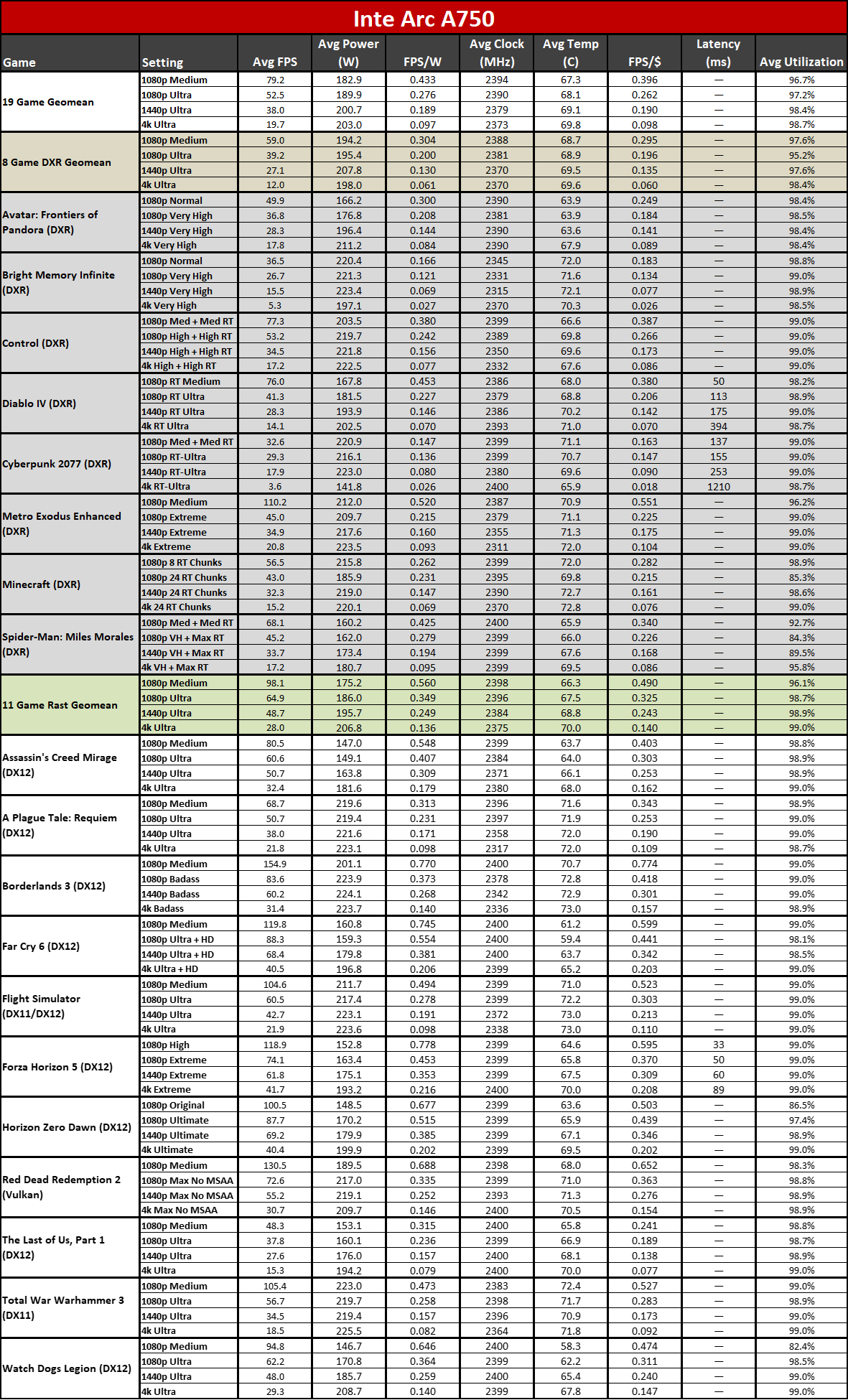
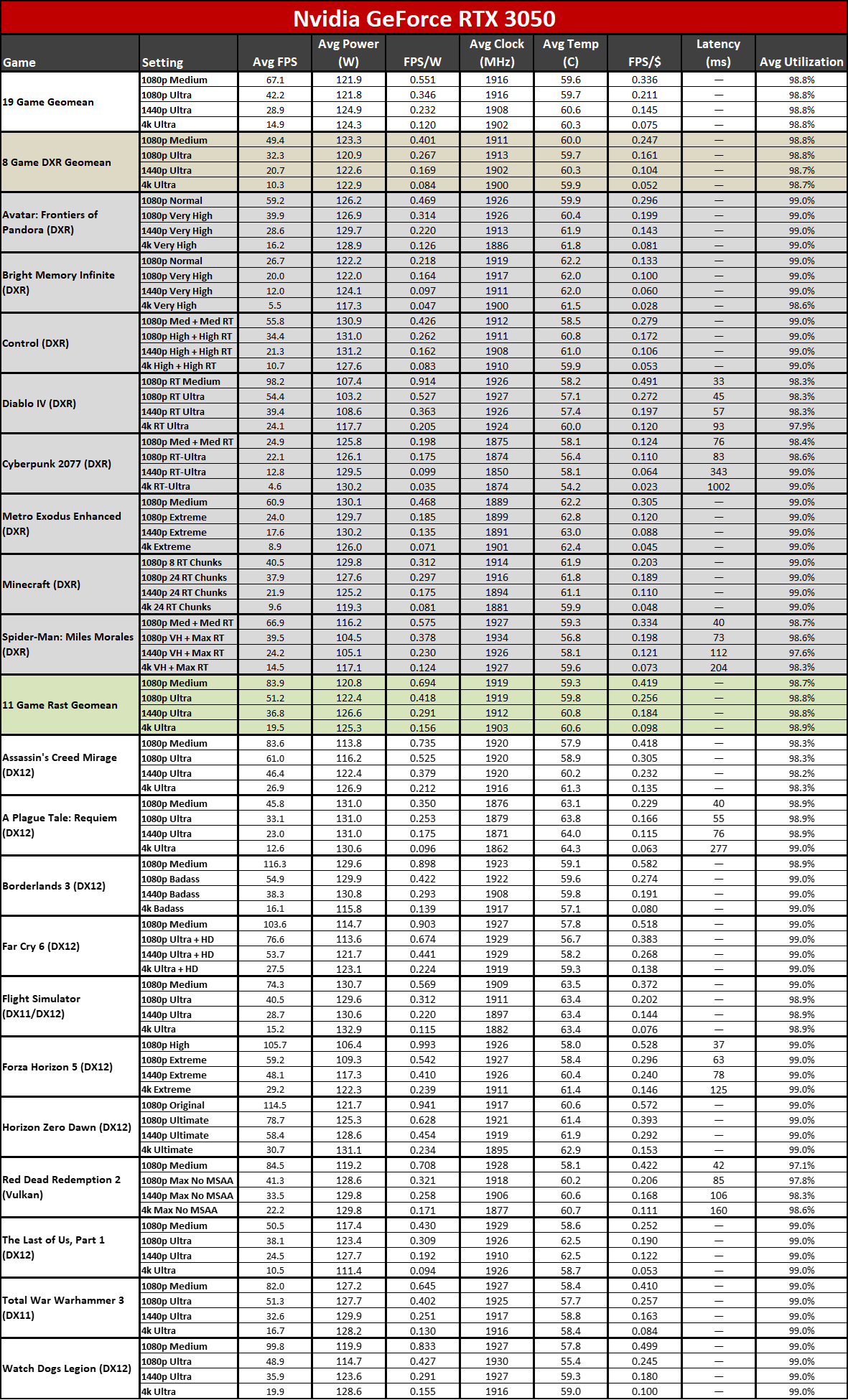
Power consumption and energy efficiency both heavily favor the RTX 3050. Even though the Arc A750 outperforms the RTX 3050 in raw performance, the RTX 3050 gets the upper hand in all of our power-related metrics. And again, this is with a less advanced manufacturing node — Nvidia's newer RTX 40-series GPUs that use TSMC's 4N process blow everything else away on efficiency right now.
The RTX 3050 pulled roughly 123 watts on average across our testing suite. Peak power use topped out at around 131W in a few cases, matching the official 130W TGP (Total Graphics Power) rating. Nvidia GPU pulled a bit less power at 1080p (122W), but basically we're GPU bottlenecked in almost all of our tests, so the card runs flat out.
The Arc A750 officially has a 225W TDP, and actual real-world power use was often 20–30 watts below that. But that's still at least 60W more power use than Nvidia's card, basically matching the power draw of the significantly faster RTX 3060 Ti. 1080p proved to be the most power efficient, averaging 183W. That increased to 190W at 1080p ultra, 201W for 1440p ultra, and 203 at 4K ultra.
Divide the framerate by power and we get efficiency in FPS/W. Across all resolutions, efficiency clearly favors the RTX 3050. It's about 25% more efficient at each test resolution and setting, for example the 3050 averaged 0.551 FPS/W at 1080p medium compared to the A750's 0.433 FPS/W.
The RTX 3050's power efficiency speaks to Nvidia's experience in building discrete GPU architectures. Even with a less advanced "8nm" process node (Samsung 8N in actuality is more of a refined 10nm-class node), going up against TSMC's "6nm" node, Nvidia comes out ahead on efficiency. The A750 wins the performance comparison, but only by using 50–65 percent more power. And that's not the end of the world, as even a 200W graphics card isn't terribly difficult to power or cool, but there's a lot of room for improvement.
Power Efficiency Winner: Nvidia
This is another area where the RTX 3050 easily takes the win. Not only does it use 30–40 percent less power, depending on the game, but it's about 25% higher efficiency. This isn't the most important metric, but if you live in an area with high electricity costs, that may also be a factor to consider. It's also worth noting that idle power use tends to be around 40W on the A750, compared to 12W on the 3050, with lighter workloads like watching videos also showing a pretty sizeable gap.
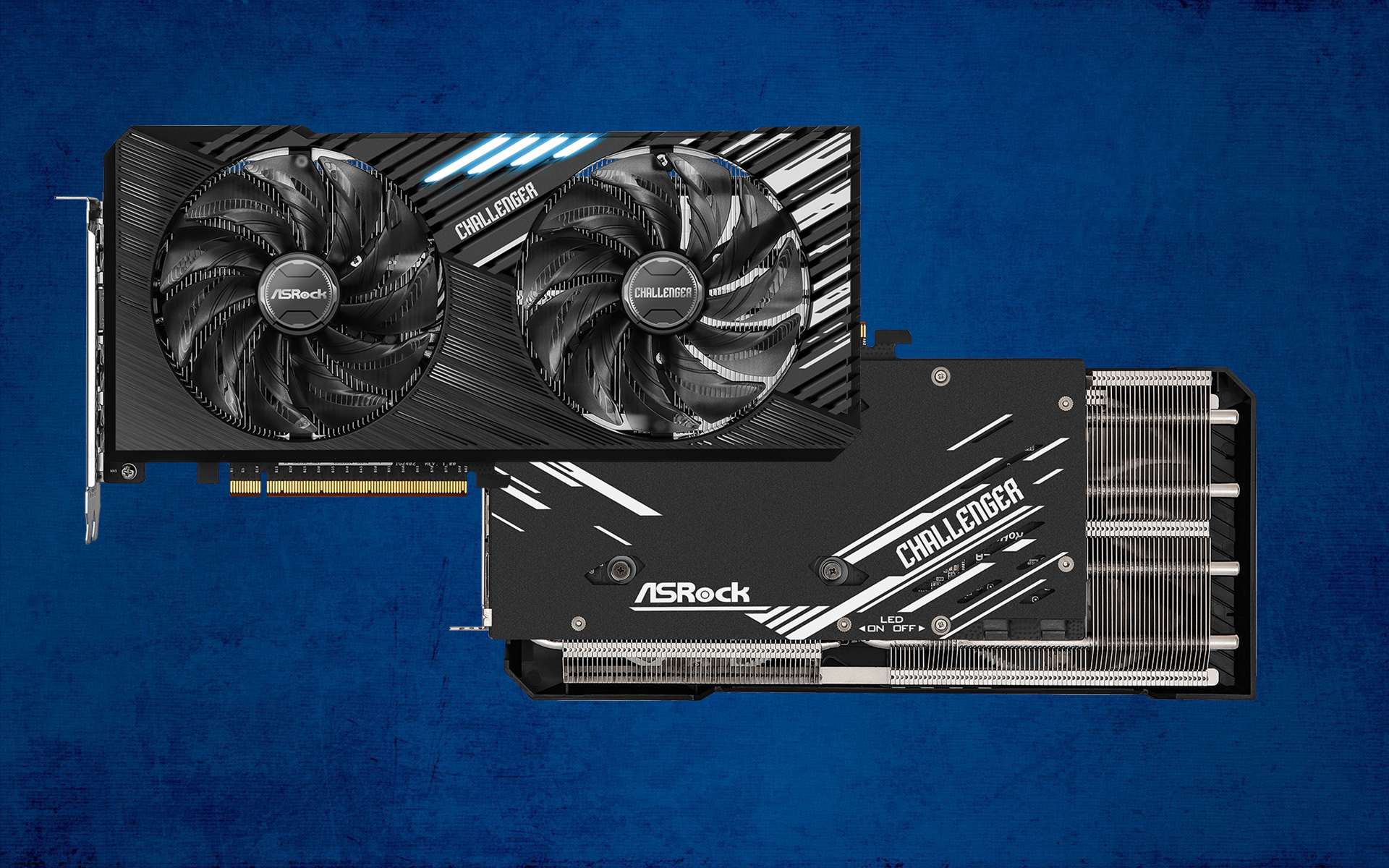
RTX 3050 vs. Arc A750 Verdict
| Header Cell - Column 0 | RTX 3050 | Arc A750 |
|---|---|---|
| Performance | Row 0 - Cell 1 | XX |
| Price | X | X |
| Features, Technology, Software | X | Row 2 - Cell 2 |
| Power and Efficiency | X | Row 3 - Cell 2 |
| Total | 3 | 3 |
Unfortunately (or fortunately, depending on your viewpoint), we are calling this one a draw. Both GPUs stand up very well against each other but have totally different strengths and weaknesses.
The brunt of the Arc A750's strength lies in its raw performance. It handily beat the RTX 3050 in rasterized games, and generally comes out ahead in ray tracing games as well — except in those cases where drivers hold it back. Thanks to its bigger GPU and higher specs, with more raw compute and memory bandwidth, it comes out with some significant performance leads. If you're willing to risk the occasional drivers snafu in new releases, and you only want the most performance per dollar spent, the A750 is the way to go. It gets two points for performance that's often the most important category in these faceoffs, plus it comes out with a relatively large lead of around 30% (unless you only play at 1080p medium).
But despite the A750's strong performance, the RTX 3050 also has a lot of upsides. Arguably, the biggest strength of the 3050 is the fact that it's an Nvidia GPU. With Nvidia hardware, you generally know you're getting a lot of extras outside of raw performance. Nvidia cards have more features (e.g. DLSS, Reflex, Broadcast, VSR) and arguably the best drivers of any GPU. CUDA apps will run on everything from a lowly RTX 3050 up to the latest RTX 4090 and even data center GPUs, as long as your GPU has sufficient VRAM for the task at hand.
Power consumption and efficiency are less essential advantages, but the gap is more than large enough to be meaningful. PC users looking to pair a budget GPU with lower wattage power supplies will be far better off with the RTX 3050 in general, as it only needs a single 8-pin (or potentially even a 6-pin) power connector and draws 130W or less. The Arc A750 doesn't usually need to use its rated 225W or power, but it's often going to end up in the 200W ballpark, and idle power also tends to be around 20W higher. That adds up over time.
For someone willing to deal with some of the potential quirks, the A750 can be enticing. It's also a lot safer if you're not playing a lot of recent releases. People who like to play around with new tech might also find it of interest, simply because it's the first serious non-AMD, non-Nvidia GPU to warrant consideration. And if you can find the A750 on sale for $175, all the better.
People who just want their graphics card to work without a lot of fuss, and to have access to Nvidia's software ecosystem, will find the RTX 3050 a safer bet. It often won't be as fast, but it can catch up in games with DLSS support (that lack FSR/XeSS support), and you're less likely to pull your hair out in frustration. Which isn't to say that anyone should buy the RTX 3050 — we declared the RX 6600 the superior card in that comparison, and nothing has changed there.
What we want now from Intel is to see Battlemage address all these concerns and come out as a superior mainstream option. We'll see what happens with the next generation GPU architectures in the next six to twelve months.
Get Tom's Hardware's best news and in-depth reviews, straight to your inbox.

Aaron Klotz is a contributing writer for Tom’s Hardware, covering news related to computer hardware such as CPUs, and graphics cards.
-
Neilbob Oh my goodness, you did it again. What is with this need to place 3050 pricing on the same level as the A750 (and RX 6600) even though the performance between the two is virtually night and day?Reply
And this time you tried to justify it by suggesting the dissipating 3050 inventory would result in higher prices, so buy it now at the (still utterly atrocious) price of $200. That is not a good enough reason.
This really annoys me. Even with its various issues, the A750 is such a better budget purchase. I don't get why the 3050 isn't getting dolloped on from a huge height, because it really does deserve it. -
Pierce2623 Reply
Realistically, against a 50 tier card, the Intel had a pretty horrible showing and even lost in some games, with a 225w TDP no less. I’m far from impressed. One last point, I thought one of the main selling points of Intel was supposedly even better ray tracing performance than Nvidia compared to overall performance but it looks like almost every Nvidia victory was in ray traced games.Neilbob said:Oh my goodness, you did it again. What is with this need to place 3050 pricing on the same level as the A750 (and RX 6600) even though the performance between the two is virtually night and day?
And this time you tried to justify it by suggesting the dissipating 3050 inventory would result in higher prices, so buy it now at the (still utterly atrocious) price of $200. That is not a good enough reason.
This really annoys me. Even with its various issues, the A750 is such a better budget purchase. I don't get why the 3050 isn't getting dolloped on from a huge height, because it really does deserve it. -
JarredWaltonGPU Reply
Have you tested and used an Intel Arc GPU? Because I have, repeatedly, for over 18 months. I still encounter regular quirks and issues. Both cards cost around $200, and even then, while Intel wins big on performance in a lot of cases, I wouldn't recommend an Arc GPU to less experienced PC builders. It's a serious case of Dr. Jekyll and Mr. Hyde, where some things are great and others are terrible.Neilbob said:Oh my goodness, you did it again. What is with this need to place 3050 pricing on the same level as the A750 (and RX 6600) even though the performance between the two is virtually night and day?
And this time you tried to justify it by suggesting the dissipating 3050 inventory would result in higher prices, so buy it now at the (still utterly atrocious) price of $200. That is not a good enough reason.
This really annoys me. Even with its various issues, the A750 is such a better budget purchase. I don't get why the 3050 isn't getting dolloped on from a huge height, because it really does deserve it.
Arc A750 competes in performance with the RTX 3060 12GB. As you can hopefully guess, that's a very generous comparison if you wanted to pretend Intel is just as fast. For one, it's the rare case where Nvidia gives you more VRAM. But the overall performance ends up, at best, roughly tied... and the quirks and issues with Arc become so much more of a factor in that case.
Wholloping on the RTX 3050 8GB in performance, most of the time, is enough to make the A750 look pretty good. It uses a lot more power, the drivers and features aren't as good, but this is what Intel needs to do to "win" a matchup: Come out way ahead on performance. Matching (or close to matching) ends up as a clear loss because of everything else — and that applies whether looking at AMD or Nvidia GPUs.
Intel still needs to improve its ecosystem of software and drivers. The only way to do that is with lots of time. It's still a big question mark on how much better (in the software/drivers area) Battlemage will end up being relative to Alchemist. Five years from now, assuming Intel dedicated GPUs stick around, we'll hopefully be able to not worry about that aspect anymore, but in the here and now? The only way to recommend Arc GPUs is with some clear qualifications and disclaimers so that people know what they're getting into. -
Neilbob ReplyPierce2623 said:Realistically, against a 50 tier card, the Intel had a pretty horrible showing and even lost in some games, with a 225w TDP no less. I’m far from impressed.
JarredWaltonGPU said:I wouldn't recommend an Arc GPU to less experienced PC builders. It's a serious case of Dr. Jekyll and Mr. Hyde, where some things are great and others are terrible.
and other stuff
Okay, I'll concede some of that, especially the power consumption - that is quite significant over the medium-term. Even so, I'd still place the A750 slightly above... with the assumption that Intel aren't suddenly going to abandon fixing and fine-tuning and things will continue to improve. That said, I'd agree that inexperienced users should avoid.
Perhaps I am a little blinded by my hatred of the 3050. I really do detest that card, and personally go out of my way to steer people away from it where possible. If it dropped to somewhere between 125-150, then I'd change my tune. But that seems unlikely at this point. -
jlake3 I bought an A380 close to launch just to see what Arc was about, and while the drivers are much improved, that doesn’t mean they’re good.Reply
After trying a couple different drivers on one of my test systems (and running DDU between each “upgrade”), now the Intel installer just won’t work? I’ve gotta extract the exe file and then point to the folder in device manager.
Same system had an issue with one of the drivers back in the 4xxx range that would hang the system ~30 seconds after boot every time. Tried redownloading and even redownloading on another PC and sneakernetting it over, and that version would bork that PC every time.
Building a system from used parts for someone right now, and thought “Let’s throw my A380 in and see what it does on this hardware” and whoops, Cyberpunk won’t launch on .5333. It launches on .5333 in my test bench, but 100% crash rate in that system unless I upgrade to .57-something. No other card or driver I tried straight failed, and that included a card each from the GTX 600 and HD 7000 families.
So I think the final 3-3 scoring is pretty spot on. In a current system running the latest/biggest DX12 titles Intel wins performance, both have effectively equal street prices at time of publication, but Intel’s drivers are still rough and as the article points out, the architecture isn’t where you’d expect it to be by die size or power consumption. -
Gururu I visited this article a few times and read it through. As someone who has been holding out on a new GPU (still using integrated) it is very helpful. Yes I have seriously considered the Arcs and the prices are making them attractive. Very disappointed that everything new looks like 2025. I just need something that can do WOW, elden ring and baldurs gate 3 at high settings 1440. Its been very challenging to make sense if any of these $200 offerings can do.Reply -
Nyara Reply
Just buy the RX 6600, it leapfrogs the RTX 3050 in performance/game compatibility/power performance, while having no driver issues.Gururu said:I visited this article a few times and read it through. As someone who has been holding out on a new GPU (still using integrated) it is very helpful. Yes I have seriously considered the Arcs and the prices are making them attractive. Very disappointed that everything new looks like 2025. I just need something that can do WOW, elden ring and baldurs gate 3 at high settings 1440. Its been very challenging to make sense if any of these $200 offerings can do.
However for 1440p I would recommend a RX 7700 XT ($350) instead. -
Eximo Replyjlake3 said:I bought an A380 close to launch just to see what Arc was about, and while the drivers are much improved, that doesn’t mean they’re good.
After trying a couple different drivers on one of my test systems (and running DDU between each “upgrade”), now the Intel installer just won’t work? I’ve gotta extract the exe file and then point to the folder in device manager.
I did the same, to keep an eye on the drivers.
I did have a lot of trouble with the last few driver updates, had to extract and point at the folder as well. The most recent install I did worked, though they need to work on the process. The install is too silent, I thought it had messed up again until the screen went black and it prompted for a restart.
Most common issue I still encounter is the failure of the HDMI audio to recover from the screen being off. Have to go into device manager and disable/enable it to get it back. Seems to do it about 1/10 ten times. -
JarredWaltonGPU Reply
I will say, out of all the Arc GPUs, the A380 is the worst I've used. (I haven't used A310, and I'm not including integrated Arc in Meteor Lake.) In theory, it should basically be something like 1/4 of an A770, but with a bit better bandwidth per GPU core. In practice, it feels like Intel has spent way more time trying to get A750 to work well, and sometimes the 'fixes' there don't fully trickle down to A380 — meaning that it feels like testing of bugs and optimizations gets done on A750, maybe not always on A380.jlake3 said:I bought an A380 close to launch just to see what Arc was about, and while the drivers are much improved, that doesn’t mean they’re good.
After trying a couple different drivers on one of my test systems (and running DDU between each “upgrade”), now the Intel installer just won’t work? I’ve gotta extract the exe file and then point to the folder in device manager.
Same system had an issue with one of the drivers back in the 4xxx range that would hang the system ~30 seconds after boot every time. Tried redownloading and even redownloading on another PC and sneakernetting it over, and that version would bork that PC every time.
Building a system from used parts for someone right now, and thought “Let’s throw my A380 in and see what it does on this hardware” and whoops, Cyberpunk won’t launch on .5333. It launches on .5333 in my test bench, but 100% crash rate in that system unless I upgrade to .57-something. No other card or driver I tried straight failed, and that included a card each from the GTX 600 and HD 7000 families.
So I think the final 3-3 scoring is pretty spot on. In a current system running the latest/biggest DX12 titles Intel wins performance, both have effectively equal street prices at time of publication, but Intel’s drivers are still rough and as the article points out, the architecture isn’t where you’d expect it to be by die size or power consumption.
For video stuff, it's fine. For gaming, on paper it should be way faster than it is in practice. Like, it's still slower than RX 6500 XT in everything. A380 has 4.2 teraflops FP32, 6GB VRAM, 186 GB/s bandwidth, and it can't beat AMD's card that has 5.8 teraflops (lots more compute) but only 4GB VRAM and 144 GB/s bandwidth. Also, 107 mm^2 die for AMD vs 157 mm^2 for Intel. Oops. -
Pierce2623 Reply
Oh I agree on the 3050 pricing. The crazy thing is they can drop the tdp from 120w to 70, cut VRAM to 6GB on a 96 bit bus and even deactivate a few hundred shaders and it only loses 15-20 % performance. In fact the 6GB model is so close on performance that it just makes the 8GB model look all the worse.Neilbob said:Okay, I'll concede some of that, especially the power consumption - that is quite significant over the medium-term. Even so, I'd still place the A750 slightly above... with the assumption that Intel aren't suddenly going to abandon fixing and fine-tuning and things will continue to improve. That said, I'd agree that inexperienced users should avoid.
Perhaps I am a little blinded by my hatred of the 3050. I really do detest that card, and personally go out of my way to steer people away from it where possible. If it dropped to somewhere between 125-150, then I'd change my tune. But that seems unlikely at this point.